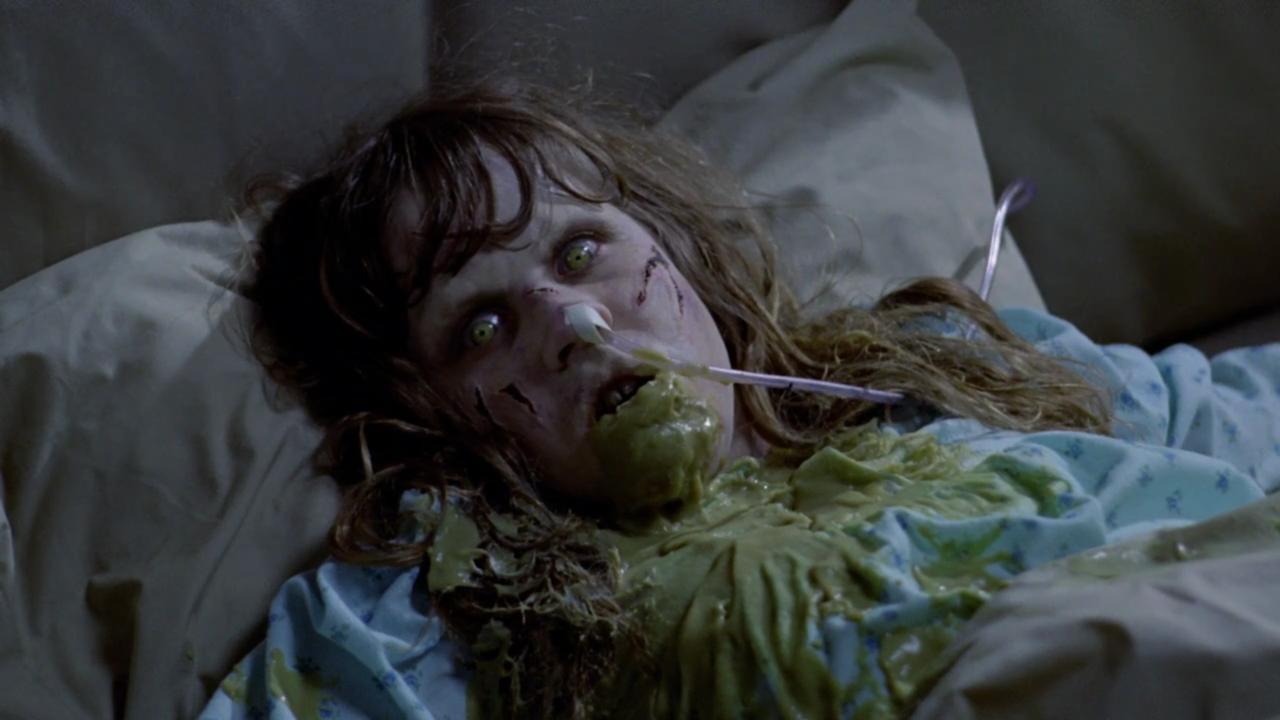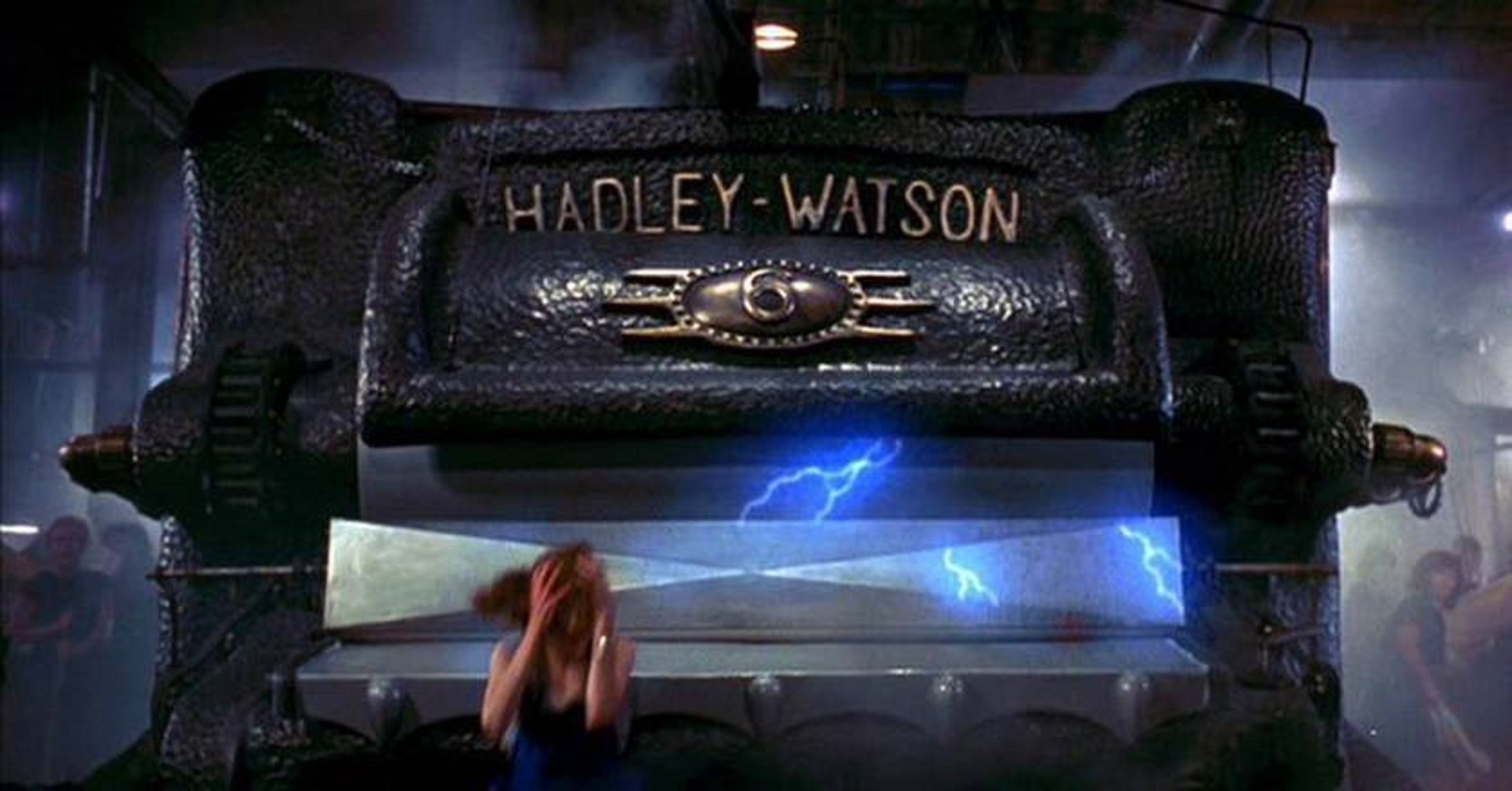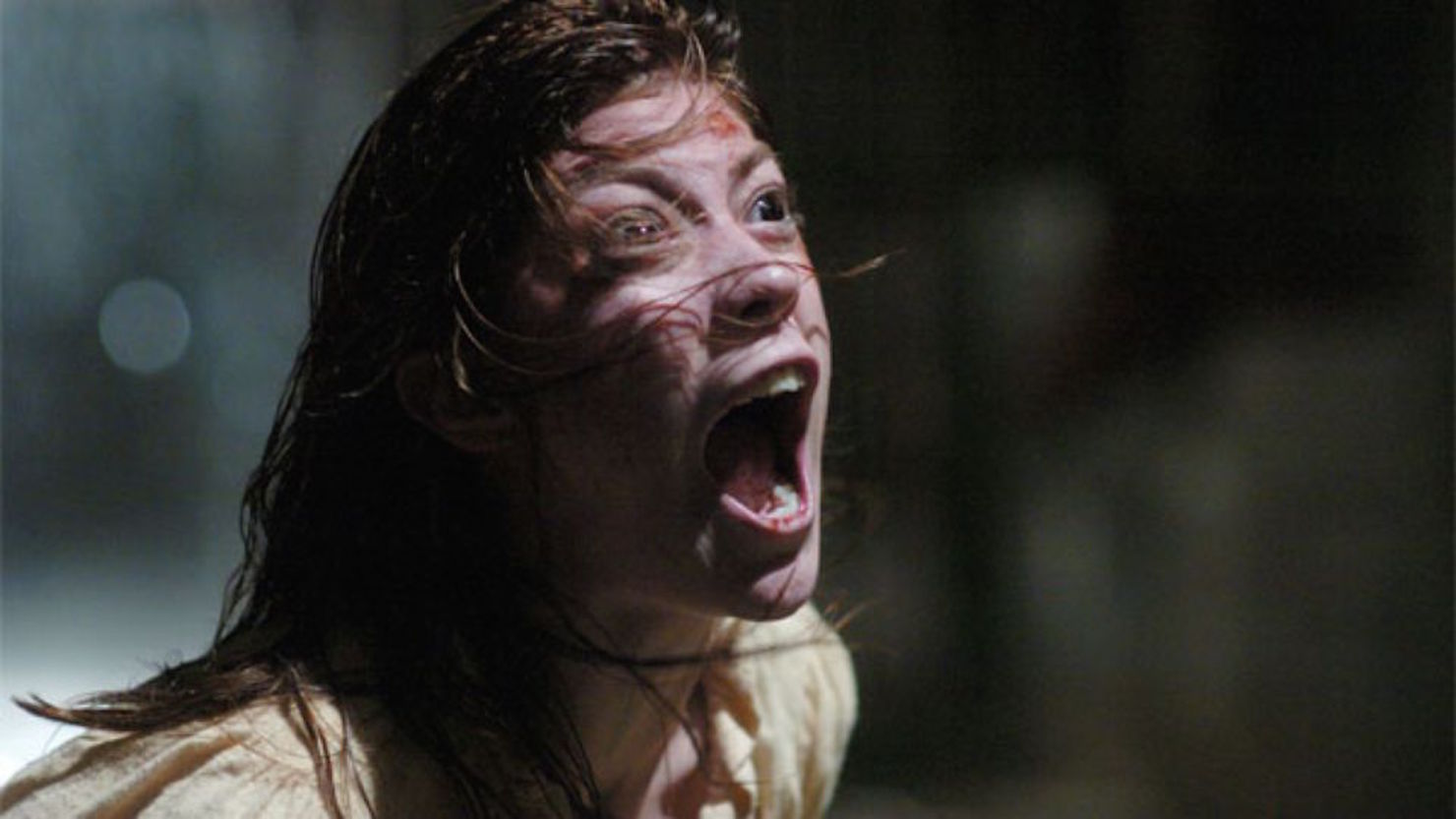Possession concerns the belief that the human body can be inhabited and control taken over by another entity. Ever since the massive success of The Exorcist (1973), cinema has been dominated by cliches of the demonically possessed.
Most commonly in possession films the possessing entity is taken to be a demonic force usually of the Christian variety, although this is not exclusively the case and there are many examples of possession that come from other cultures. Furthermore, there are a number of works dealing with non-demonic possession, usually in the form of spirits of the dead or malevolent entities.
Possession is almost always something that is seen as an evil that necessitates a battle for the possessee’s body. That said, there are also several treatments in a non-threatening, light fantasy vein.
See also: Exorcism Films and Films About Demons. For possession by alien entities see Alien Possession.
The Early Days
Films dealing with possession date all the way back to at least the silent era and The Hands of Orlac (1924) in which pianist Conrad Veidt believed he was being controlled after having the hands of a murderer surgically grafted on (even if the film eventually opted for an absurdly contrived mundane explanation). This underwent several remakes most notedly the Hollywood version Mad Love (1935) and the lesser The Hands of Orlac (1960) and Hands of a Stranger (1962).
There are occasional supernatural possession films prior to The Exorcist with the likes of Supernatural (1933), and several of Roger Corman’s Edgar Allan Poe films starring Vincent Price with the Morella episode of Tales of Terror (1962), The Haunted Palace (1963) and The Tomb of Ligeia (1964), while Price also appeared in the non-Corman Diary of a Madman (1963). In The Skull (1965), Peter Cushing was taken over by the skull of the Marquis de Sade. There was also the high-profile The Possession of Joel Delaney (1972) with Perry King inhabited by the spirit of a Puerto Rican killer. Black Sunday (1960) and Revenge of the Blood Beast (1965) featured modern-day women inhabited by witches who were burned at the stake.
In these films, possession comes in the form of a disembodied soul that has latched onto the living and demons do no feature. They show how things might have gone had the genre not become dominated by demonic possession tropes following The Exorcist.
The Exorcist and After
The most influential work in the genre was The Exorcist (1973) in which a twelve year-old Linda Blair is possessed by a demon. The shock of the film was seeing a child mouthing obscenities, projectile vomiting and masturbating with a crucifix. The film also introduced the stalwart exorcists in the form of Catholic priests who have been regarded as the frontline defenders against demonic incursions ever since.
The Exorcist was one of the biggest box-office successes of its day and led to multiple copies – not to mention a huge increase in real-life exorcists and claimed instances of possession. The film was written by William Peter Blatty, a former Jesuit seminarian, who saw the story as a battle about faith (something that the following copies had little interest in, instead making a beeline for shock theatrics).
The elements of possession that The Exorcist introduced – the possessed with hideous and cracked face, taunting obscenities, vomiting, levitating objects and of Catholic priests of resolute faith chanting “The power of Christ compels you” – have dominated the genre. In forty years, the possession genre has failed to move beyond the endless regurgitation of these cliches.

The Exorcist led to several sequels with the much hated Exorcist II: The Heretic (1977), The Exorcist III (1990), which is a much better, more subtle film, and the competing prequels Exorcist: The Beginning (2004) and Dominion: Prequel to The Exorcist (2005), as well as the tv series The Exorcist (2016-8) and the ridiculous revival with The Exorcist: Believer (2023).
The Exorcist‘s director William Friedkin examines the actuality of the possession phenomenon in the documentary The Devil and Father Amorth (2017). Blatty based the story on a reportedly true incident in 1947 – the otherwise dreadful Possessed (2000) is a film supposedly based on those events, while Exorcist: House of Evil (2016) makes the entirely untrue claim to be shot in the house where this exorcism took place and The Haunted Boy: The Secret Diary of the Exorcist (2010) is a bogus ghost hunter documentary that makes spurious claim to investigate the house.
The Exorcist produced a number of copies such as Abby (1974), The Devil’s Female (1974), The Devil Within Her/I Don’t Want to Be Born (1975), Exorcism (1975), Good Against Evil (1977), The Possessed (1977), Amityville II: The Possession (1982), and a host of Italian exploitation efforts with The Antichrist/The Tempter (1974), Beyond the Door (1974), The Sexorcist (1974), The Night Child (1975), The Return of the Exorcist (1975), Malabimba (1979) and The Other Hell (1981), even the spoof The Exorcist: Italian Style (1975).
Surprisingly, The Exorcist has produced an industry of Bollywood copies such as Raat (1992), Bhoot (2003), 1920 (2008) and sequels, Phoonk (2008) and Raaz Reboot (2016).
The 1980s
Films of the 1980s move towards a much more over-the-top, splatter and makeup-effects driven form of horror. The progenitor of these was The Evil Dead (1981), which produced the sequels The Evil Dead II (1987), Army of Darkness (1992) and the tv series Ash vs Evil Dead (2015-8), featuring Bruce Campbell in a ferocious and increasingly tongue-in-cheek battle against the possessed dead (where zombies and the possessed seem interchangeable), This was followed by a remake Evil Dead (2013) and a soft reboot Evil Dead Rise (2023).
There are other efforts in the same vein as The Evil Dead with the likes of Mausoleum (1983), Scalps (1983), Demons (1985) and sequels, Killer Party (1986), Hello Mary Lou: Prom Night II (1987), Night of the Demons (1987) and sequels, Retribution (1987), Scared Stiff (1987), The Kiss (1988), Nightmare Sisters (1988) and 976-Evil (1988). By the time of [Rec] (2007) and sequels, we essentially have a zombie outbreak film with a nominal demonic possession explanation.
There are occasional modern variants such as The Convent (2000), Jack Brooks, Monster Slayer (2007), Jennifer’s Body (2009) and Deathgasm (2016), which adopt an effects driven and/or tongue-in-cheek attitude towards possession. May the Devil Take You (2018) is a modern homage to the Evil Dead-styled possession film.
Non-Demonic Possession
There has been a steady variety of non-demonic possession films. Frequently in these films, the possessing entity is the soul of someone who has died including the likes of:- such as Meredith Baxter inhabited by a murdered woman seeking her killer following an assault in The Invasion of Carol Enders (1973), an ex-girlfriend in Lorna the Exorcist (1974), dead mobsters in J.D.’s Revenge (1976) and Ruby (1977), a cult leader in Nurse Sherri (1978), a Salem witch in The Coming (1981), Native American spirits in Last Gasp (1995), a co-worker’s suicided wife in Lemming (2005), an ex-wife in Between Worlds (2018), and assorted other possessions in Paranormal Activity (2007) and sequels, Insidious (2010) and sequels, The Violent Kind (2010), The Ouija Exorcism (2015), Demon Tongue (2016), Ouija: Origin of Evil (2016) and Prey (2019). Down a Dark Hall (2018) is about a girl’s school where pupils are taken over by dead students in order to continue their work, while Talk to Me (2022) sees teens playing around with an occult artifact that allows them to become briefly possessed as a party stunt.
Beyond possession by the dead, there are a number of other explanations on offer David Warner inhabited by a murderous spirit from a mirror in From Beyond the Grave (1974), possession by a malevolent tumour in The Abomination (1986), Viking spirits in Berserker: The Nordic Curse (1987), Ray Wise possessed by the spirit of Bob in the tv series Twin Peaks (1990-1) and the film Twin Peaks: Fire Walk With Me (1992), the body-hopping parasite of Jason Goes to Hell: The Final Friday (1993), the Hindu goddess Kali in Temptress (1995), a djinn in Long Time Dead (2002), Ron Perlman’s sheriff taken over by something unearthed in the Stephen King mini-series Desperation (2006), a mask in You Might Be the Killer (2018) and a childhood imaginary companion in Daniel Isn’t Real (2019).

One minor fad during the 1980s was a spate of films about executed killers returning from the dead to possess the living. Wes Craven’s Shocker (1989) featured an executed killer come back from the electric chair and passing through a host of bodies on a mission of revenge. This started off a minor spate of possession films about body-hopping killers with the likes of The Chair (1989), The Horror Show (1989), The First Power (1990) and Judge and Jury (1996). We have also seen such notable latter-day efforts as Fallen (1998), Don’t Kill It (2016) and Becoming (2020), which conduct imaginative takes on the premise.
Other oddities among these include the possessed title vehicle in The Car (1977); Death Bed: The Bed That Eats (1977) about a demonically-possessed bed; Child’s Play (1988) and sequels about a serial killer whose spirit possesses a child’s doll; I’m Dangerous Tonight (1990) about a dress that possess its wearer; The Mangler (1995) with a possessed laundry press; the animated Monster House (2006) about a possessed house; a clown costume that possesses its wearer in Clown (2014); and possessed animatronic robots in Willy’s Wonderland (2021).
The 2000s Revival of the Exorcism Genre
The traditional Exorcist-inspired possession and exorcism genre made a considerable rebound during the late 1990s/2000s with efforts such as Stigmata (1999), Lost Souls (2000), Blackwater Valley Exorcism (2006), The Unborn (2009), Seance: The Summoning (2011), Exorcism: The Possession of Gail Bowers (2006), Devil in My Ride (2013), Exorcist Chronicles (2013), The Vatican Exorcisms (2013), The Exorcism of Molly Hartley (2014), Exorcist: The Fallen (2014), High School Possession (2014), Backmask/Exeter (2015), The Priests (2015), The Vatican Tapes (2015), Exorcist: House of Evil (2016), Incarnate (2016), The Secrets of Emily Blair (2016), American Exorcism (2017), American Guinea Pig: The Song of Solomon (2017), Amityville Exorcism (2017), the Mashit episode of Nightmare Cinema (2018), Awoken (2019), The Dawn (2019), Devil’s Whisper (2019), The Last Exorcist (2020), Agnes (2021), The Exorcism of God (2021), Know Fear (2021), The Seventh Day (2021), The Chosen One/Sadistic: The Exorcism of Lily Deckert (2022), Exorcist Vengeance (2022), Prey for the Devil (2022), Exorcism in Utero (2023) and The Exorcists (2023), as well as the tv series revival of The Exorcist (2016-8). The cliches and tropes laid down by The Exorcist dominate these films with a frustratingly repetitive lack of variation.
Amidst these, there was the substantial hit of The Exorcism of Emily Rose (2005), which made stringent claims to be based on the true story of Annelise Michel who died during an exorcism in the 1970s (although the film widely embellished the actual details to the point of almost total fiction). Following this, there have been several other supposedly ‘based of a true story’ exorcism and possession films with The Rite (2011), The Possession (2012), The Conjuring (2013), Deliver Us From Evil (2014), The Exorcism of Anna Ecklund (2016), The Crucifixion (2017), Veronica (2017), The Conjuring: The Devil Made Me Do It (2021), The Exorcism in Amarillo (2020), Godless: The Eastfield Exorcism (2023), The Pope’s Exorcist (2023), The Deliverance (2024) and The Ritual (2025).

A number of these films have offered Found Footage treatments such as Chronicles of an Exorcism (2008), Back from Hell (2011), the popular hit of The Devil Inside (2012), The Taking of Deborah Logan (2014), Proof of the Devil (2015), The Devil’s Doorway (2018) and the unique The Atticus Institute (2015). There was also the point-of-view shot Grace (2014), the webcam film Possession Diaries (2019) and The Cleansing Hour (2019), which takes place via livestream. We even had Anneliese: The Exorcist Tapes (2011) and The Exorcist File (2014), which respectively claim to be uncovered films taken of the Anneliese Michel and the supposed true-life The Exorcist exorcisms. The most original of these was Late Night With the Devil (2023), which took placed as a mock-up of a 1970s tv talkshow.
The most original of these Found Footage films was The Last Exorcism (2010) concerning a preacher who has lost his faith and fakes the exorcisms he performs only to then be faced with a genuine case of possession. Another unique entry was The Exorcism (2024), a film directed by the son of Jason Miller (who played Father Karras in The Exorcist) where Russell Crowe plays an actor taking on the part of Miller’s priest in a remake of The Exorcist.
One of the strangest recent fads to emerge is the combination of possession with Virtual Reality themes where someone can enter the dreamscape of the possessed as can be seen in Exorcist II: The Heretic (1977), Incarnate (2016) and Demonic (2021).
Other Voices
At direct contrast to The Exorcist’s blind acceptance of Catholic dogma was Ken Russell’s The Devils (1971) based on a true incident at a 17th Century convent, which sees that possession is no more than superstition and sexual hysteria and exorcism as a tool of political oppression by the Catholic Church.
Also of interest is Requiem (2006), a contrary telling of the Emily Rose/Anneliese Michel story that offers mental illness as an explanation. Of Love and Other Demons (2010) has an 18th Century priest sent to question a woman who is suspected of being possessed and falling for her. Demons (2017) progresses as a standard possession and exorcism film before the revelation there is no possession, just an abuse victim, and in a similar vein In the Trap (2019) starts out seeming a film about possession before revealing these are the beliefs of a severely disturbed individual.
There are films that depict possession from other religions and culture such as possession by a Jewish dybbuk in The Dybbuk (1937), The Possession (2012) and Demon (2015); an Ancient Egyptian mummy queen in Blood from the Mummy’s Tomb (1971) and The Awakening (1980); Japanese ghosts in The House Where Evil Dwells (1982); assorted spirits in the Japanese Bugmaster (2006); the fascinating Taiwanese Soul (2013); the Chinese Life After Life (2016); the South Korean The Wailing (2016), The 8th Night (2021) and Exhuma (2024); and spirits from Thai ghost houses in Ghost House (2017) and the Thai The Medium (2021).
Comedy, Gonzo and Light Fantasy
In less serious efforts there are the likes of Danny Kaye taken over by his twin brother in Wonder Man (1944); a woman taken over by a dead Hollywood starlet in Maxie (1985) and the unofficial erotic film remake Erotic Possessions (2000); a nerdy girl possessed in Girlfriend from Hell (1989); Heart and Souls (1993) with Robert Downey Jr possessed by four different people to complete their unfinished business; Brendan Fraser possessed by a disembodied monkey in Monkeybone (2001); and the romcom Just Like Heaven (2015) where Mark Ruffalo is inhabited by a comatose Reese Witherspoon.
In the unserious vein, we had a possessed refrigerator in The Refrigerator (1991); a stripper possessed by a demonic toon in Evil Toons (1992); Killer Tongue (1996) about a woman with a possessed tongue; Idle Hands (1999) about a slacker with a demonically possessed hand; an executed killer who inhabits a gingerbread man in The Gingerdead Man (2006) and sequels from Full Moon, while the same company later made Evil Bong (2006) and sequels about a possessed marijuana bong then then crossed both series over; She Kills (2016) about a woman with a possessed vagina; Killer Sofa (2019) about a possessed recliner chair; Slaxx (2020) with a possessed pair of jeans; and Demonic Christmas Tree (2022) about a possessed Christmas tree.
In the realm of the completely strange was Billy’s Holiday (1995) about a middle-aged man possessed by the spirit of Billie Holliday and Being John Malkovich (1999) in which a doorway in an office building allows people to inhabit the body of actor John Malkovich.
The film Ghost (1990) takes the point-of-view of Patrick Swayze after he is killed and depicts how possession might occur from this perspective as he briefly inhabits Whoopi Goldberg.
Probably the most unique of all treatments was Every Day (2018), a Young Adult film about a girl who has a romance with a being who wakes up possessing the body of a different person every day.
The Exorcist was parodied in Repossessed (1990) and Scary Movie 2 (2000). Possession cliches are also spoofed in Ghostbusters (1984) and sequels, Teenage Exorcist (1991), Idle Hands (1999), Little Nicky (2000), A Haunted House (2013) and sequel, 30 Nights of Paranormal Activity with the Devil Inside the Girl with the Dragon Tattoo (2013), Hell Baby (2013) and Exorcism at 60,000 Feet (2020).
Recommendations
- The Hands of Orlac (1924)
- Mad Love (1935)
- The Devils (1971)
- The Possession of Joel Delaney (1972)
- The Exorcist (1973)
- The Evil Dead (1981)
- The Exorcist III (1990)
- Fallen (1998)
- Requiem (2006)
- The Last Exorcism (2010)
- The Rite (2011)
- Soul (2013)
- The Atticus Institute (2015)
- Don’t Kill It (2016)
- Every Day (2018)
- The 8th Night (2021)
- Late Night With the Devil (2023)
- The Exorcism (2024)
A full list of titles can be found here Possession

